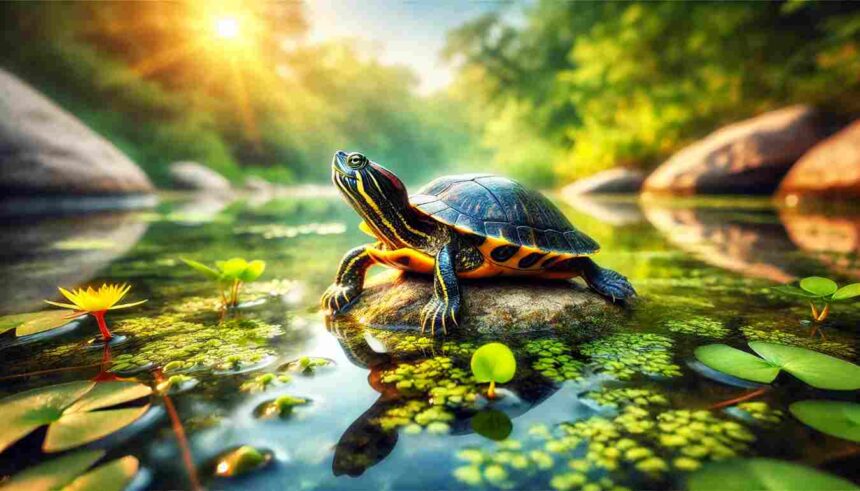The Yellow Bellied Slider is a type of freshwater turtle that is known for its distinct yellow markings and its playful, energetic nature. It is one of the most popular pet turtles around the world, thanks to its friendly temperament and beautiful appearance.
What is a Yellow Bellied Slider?
The Yellow Bellied Slider, scientifically known as Trachemys scripta scripta, is a subspecies of the Eastern Slider turtle. Native to the southeastern United States, it gets its name from the bright yellow markings on its belly and the striking yellow lines on the sides of its head.
These turtles have a smooth, dark shell that is typically olive or brown with yellowish streaks, and their size can range from 8 to 13 inches long.
Yellow Bellied Sliders are often seen basking in the sun, and they are semi-aquatic, meaning they spend much of their time in the water but also need a dry area to rest and bask.
This combination of aquatic and terrestrial life is something you need to replicate in a suitable habitat to keep your pet happy.
Natural Habitat of the Yellow Bellied Slider
In the wild, Yellow Bellied Sliders can be found in ponds, lakes, rivers, and marshes across the southeastern United States.
They prefer slow-moving water, where they can swim and hunt for food. These turtles are also highly adaptable and can live in a range of environments, including both fresh and brackish waters.
In their natural habitat, they spend a considerable amount of time basking in the sun on logs, rocks, or shores. The sun helps them regulate their body temperature and absorb necessary UVB rays, which are vital for their health and shell development.
Creating the Right Habitat at Home
When setting up a habitat for a Yellow Bellied Slider, it’s essential to mimic their natural environment as much as possible. Here are the key components you need to consider:
1. Aquarium Size
Yellow Bellied Sliders need ample space to swim and explore. The minimum recommended tank size for a single adult slider is 75 gallons, but larger tanks are always better. A larger tank will allow your turtle to swim freely and reduce stress. For each additional turtle, you will need an extra 25-50 gallons of water.
2. Water Conditions
The water temperature for Yellow Bellied Sliders should be between 75°F and 80°F (24°C to 27°C). Use an aquarium heater to maintain a consistent temperature, especially if you live in a cooler climate. The water should be filtered to keep it clean, as turtles are messy creatures. A strong filter will help maintain water quality by removing waste, debris, and uneaten food. Regular water changes are also necessary to keep the environment healthy for your turtle.
3. Basking Area
In addition to a large swimming area, your Yellow Bellied Slider needs a dry basking area where it can climb out of the water to rest and warm up. This area should be equipped with a heat lamp to create a basking temperature of about 85°F to 90°F (29°C to 32°C). UVB lighting is also crucial, as it helps the turtle produce vitamin D3, which is necessary for strong bones and shell growth.
The basking area can be created using a piece of driftwood, rocks, or a turtle dock that provides a stable and accessible platform for your turtle to climb onto. It is essential to ensure that the basking platform is positioned close to the heat lamp, but not too close to avoid burns.
4. Substrate
For the substrate (the material at the bottom of the tank), you can use large river rocks or gravel that cannot be ingested. Avoid small pebbles or sand, as your turtle may accidentally ingest them, which can cause digestive issues. A clean, smooth surface is ideal for your turtle to move around without getting hurt.
5. Tank Decorations and Plants
Yellow Bellied Sliders enjoy hiding in plants or decorations. Adding live or artificial aquatic plants can provide hiding spots and make the environment feel more natural. Some plants, such as anacharis or water lettuce, can even help improve water quality by absorbing excess nutrients.
6. Water Depth
A depth of 6 to 12 inches is usually adequate for young turtles, but as your Yellow Bellied Slider grows, you may need to increase the water depth. Adult turtles need more space to swim, and they will appreciate having room to dive and explore.
Yellow Bellied Slider Diet
A balanced diet is crucial for the health and longevity of your Yellow Bellied Slider. These turtles are omnivores, which means they eat both animal and plant matter. Here’s how to feed your pet:
1. Commercial Turtle Food
There are many high-quality commercial turtle pellets available that can provide essential nutrients for your turtle. Look for a brand that contains a mix of plant and animal protein, vitamins, and minerals. Pellets should be offered as part of a varied diet.
2. Vegetables and Fruits
Yellow Bellied Sliders enjoy eating leafy greens like collard greens, kale, and dandelion greens. You can also offer vegetables like carrots, zucchini, and bell peppers. Fruits like strawberries, blueberries, and apples can be fed occasionally as a treat.
3. Animal Protein
Animal protein is essential for the growth and development of your turtle. You can feed them insects such as crickets, worms, and mealworms. Some pet owners also offer small pieces of fish or shrimp. Be sure to remove any uneaten food from the tank to keep the water clean.
4. Calcium and Supplements
Yellow Bellied Sliders require calcium for healthy shell growth. Offering calcium supplements, such as cuttlebone or a calcium powder, will help prevent shell deformities. You can sprinkle calcium powder onto their food a few times a week.
Feeding Schedule
Juvenile turtles require more frequent feedings, typically once or twice a day. Adult turtles can be fed every other day or every third day, depending on their size and activity level. Be mindful not to overfeed your turtle, as obesity can lead to health problems.
Common Health Issues
Yellow Bellied Sliders are generally hardy and resilient turtles, but they are still prone to some health issues. Here are a few common problems to watch out for:
1. Shell Rot: Shell rot is a bacterial or fungal infection that can occur if the turtle’s shell is exposed to poor water quality or trauma. It is essential to maintain a clean tank and ensure your turtle has a proper basking area to keep its shell dry.
2. Respiratory Infections: Cold water, poor water quality, and stress can lead to respiratory infections in Yellow Bellied Sliders. Symptoms include wheezing, coughing, or discharge from the nose or eyes. If you notice these signs, it’s important to consult a veterinarian experienced with reptiles.
3. Vitamin Deficiencies: Lack of proper UVB lighting or an unbalanced diet can lead to vitamin D3 and calcium deficiencies. These can cause shell deformities and bone problems. Ensure that your turtle has access to proper UVB lighting and a nutritious diet.
4. Mites and Parasites: Turtles can sometimes develop external parasites, such as mites. If you notice small white spots on your turtle’s skin or shell, consult with a vet for treatment options.
FAQs
1. What size tank does a Yellow Bellied Slider need?
Adult Yellow Bellied Sliders require a spacious tank, with a minimum of 75 gallons recommended for a single turtle.
2. How long do Yellow Bellied Sliders live?
With proper care, these turtles can live over 30 years in the wild and up to 40 years in captivity.
3. What do Yellow Bellied Sliders eat?
They are omnivores, enjoying a diet of leafy greens, vegetables, fruits, insects, and small fish.
4. Do they need UVB lighting?
Yes, UVB lighting is essential for Vitamin D3 synthesis, aiding in calcium metabolism and preventing metabolic bone disease.
5. How often should I clean their tank?
Regular cleaning is vital. Perform partial water changes weekly and clean the entire tank every 3 months to maintain water quality.
6. Can Yellow Bellied Sliders be kept with fish?
It’s generally not advisable, as turtles may view fish as food.
7. What is their lifespan?
They can live over 30 years in the wild and up to 40 years in captivity with proper care.
8. Do they need a basking area?
Yes, a basking area with appropriate lighting allows them to dry off, warm up, and absorb UVB rays essential for their health.
9. Are they legal to own as pets?
In many regions, including the USA and Europe, Yellow Bellied Sliders are legal to own. However, it’s essential to check local regulations, as some areas may have restrictions or require permits.
10. How can I tell if my turtle is male or female?
Females are generally larger than males. Males have longer claws and tails.
11. Do they hibernate?
In the wild, they may enter a state of dormancy during colder months. In captivity, it’s not necessary, and they can remain active year-round if provided appropriate temperatures.
12. How can I keep their water clean?
Invest in a high-quality filtration system and perform regular water changes to maintain cleanliness and prevent health issues.
13. Can they live outdoors?
With a secure, predator-free environment and appropriate climate, they can live outdoors. Ensure they have access to basking areas and are protected from potential threats.
14. Are they social animals?
While they may recognize their owners, they are not particularly social and prefer minimal handling.
15. What are common health issues?
Be attentive to signs of respiratory infections, shell rot, and vitamin deficiencies. Maintaining proper diet, lighting, and water quality helps prevent these issues.
























